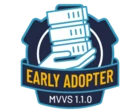Further to the fun I had trying to get the SEQ.NUM option to work on a dynamic file creation in a Pick account, I am now having extra fun with dynamic files.
I'm kind of thinking the manuals on this subject are not at all helpful - there are lots of plain syntax explanations but none of the nuanced guidance needed to actually master this stuff.
My current challenge is to create a Dynamic file with specific Dictionary specifications (the default of 'Type 3, Modulo 1, Separation 2' are not appropriate) and with non-default dynamic file settings.
Given the issues with Pick-style CREATE.FILE and dynamic files I thought I would simply create the DICT file first, then create the data file.
This is how that turned out:
>CREATE.FILE DICT TESTFILE1 53,2,18
Creating file "D_TESTFILE1" as Type 18, Modulo 53, Separation 2.
Added "@ID", the default record for RetrieVe, to "D_TESTFILE1".
>ICREATE.FILE DATA TESTFILE1 30 GENERAL GROUP.SIZE 6 MINIMUM.MODULUS 2456
"TESTFILE1" already has a DATA definition record.
File name =
File not created.
>
So, that is a strange outcome. The ICREATE.FILE seems to want to create everything.
I tried again with the DYNAMIC keyword instead of 30 (in case the keyword is important)
>CREATE.FILE DICT TESTFILE1 53,2,18
Creating file "D_TESTFILE1" as Type 18, Modulo 53, Separation 2.
Added "@ID", the default record for RetrieVe, to "D_TESTFILE1".
>ICREATE.FILE DATA TESTFILE1 DYNAMIC GENERAL GROUP.SIZE 6 MINIMUM.MODULUS 2456
"TESTFILE1" already has a DATA definition record.
File name =
File not created.
>
Ok - so that also does not work.
------------------------------
Gregor Scott
Software Architect
Pentana Solutions Pty Ltd
Mount Waverley VIC AU
------------------------------








